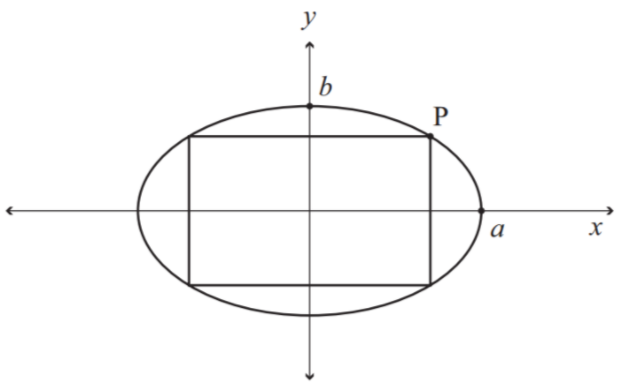
Answer
443.7k+ views
Hint: We can assume a rectangle inside an ellipse now we know that general coordinates of any point is \[(acos\theta ,bsin\theta )\] , so we consider 4 vertices of rectangles as \[(acos\theta ,bsin\theta ), (acos\theta ,-bsin\theta ), (-acos\theta ,bsin\theta ) and (-acos\theta ,-bsin\theta )\]
So side length of rectangle will be \[2acos\theta \] and \[2bsin\theta \] so its area will be \[ab4sin\theta cos\theta \]
Now we have to maximize area by differentiating and equating 0, and double differentiating and equating < 0.
Complete step-by-step solution:
We are given an ellipse \[\dfrac{{{x}^{2}}}{{{a}^{2}}}+\dfrac{{{y}^{2}}}{{{b}^{2}}}=1\] and a rectangle is inscribed in it so as we know general coordinates of any point in ellipse of equation \[\dfrac{{{x}^{2}}}{{{a}^{2}}}+\dfrac{{{y}^{2}}}{{{b}^{2}}}=1\] is \[(acos\theta ,bsin\theta )\]

So, we take general vertices of rectangle as \[(acos\theta, bsin\theta ), (acos\theta, -bsin\theta ), (-acos\theta, bsin\theta ) and (-acos\theta, -bsin\theta )\]
So, we can see that length and breadth of rectangle is \[2acos\theta \] and \[2bsin\theta \]
So, its area will be \[ab4sin\theta cos\theta \] (length x Breadth)
Applying trigonometric formula \[2sin\theta cos\theta =\sin 2\theta \], let area equals to A
Now \[A=2ab\sin 2\theta \]
Now as its the area is maximum given in question, we have to differentiate it with respect to \[\theta \]
\[\dfrac{dA}{d\theta }=2ab\cos 2\theta \times 2\] (using \[\dfrac{d\sin 2\theta }{d\theta }=2\cos 2\theta \])
Equating \[\dfrac{dA}{d\theta }=2ab\cos 2\theta \times 2=0\], it means \[\cos 2\theta =0\] , which means \[2\theta =\dfrac{\pi }{2}\] and \[\theta =\dfrac{\pi }{4}\]
But we have to check that at \[\theta =\dfrac{\pi }{4}\] area is maximum and not minimum
For that we have to calculate \[\dfrac{{{d}^{2}}A}{d{{\theta }^{2}}}\]
Which will be equals to \[\dfrac{{{d}^{2}}A}{d{{\theta }^{2}}}=4ab(-\sin 2\theta )\times 2\]
On solving further equals to \[\dfrac{{{d}^{2}}A}{d{{\theta }^{2}}}=-8ab(\sin 2\theta )\] now putting \[\theta =\dfrac{\pi }{4}\] we get
\[\dfrac{{{d}^{2}}A}{d{{\theta }^{2}}}=-8ab\], which is a negative quantity hence we can say that area is maximum at \[\theta =\dfrac{\pi }{4}\]
So now we to put \[\theta =\dfrac{\pi }{4}\] in equation of area which is \[A=2ab\sin 2\theta \]
We get as \[A=2ab\sin 2\dfrac{\pi }{4}=2ab\sin \dfrac{\pi }{2}=2ab\]
Hence max area of rectangle inside ellipse is \[2ab\].
Note: If instead of ellipse we are given a circle \[{{x}^{2}}+{{y}^{2}}={{r}^{2}}\] and to find area of the greatest rectangle that can be inscribed in it , again we can apply same procedure but this time the coordinates are \[(rcos\theta ,rsin\theta ),(rcos\theta ,-rsin\theta ),(-rcos\theta ,rsin\theta )and(-rcos\theta ,-rsin\theta )\]
So, we can see that length and breadth of the rectangle is \[2rcos\theta \] and \[2rsin\theta \]. So, its area will be \[{{r}^{2}}4sin\theta cos\theta \] (length x Breadth)
And after differentiating it results into \[2{{r}^{2}}\]
So side length of rectangle will be \[2acos\theta \] and \[2bsin\theta \] so its area will be \[ab4sin\theta cos\theta \]
Now we have to maximize area by differentiating and equating 0, and double differentiating and equating < 0.
Complete step-by-step solution:
We are given an ellipse \[\dfrac{{{x}^{2}}}{{{a}^{2}}}+\dfrac{{{y}^{2}}}{{{b}^{2}}}=1\] and a rectangle is inscribed in it so as we know general coordinates of any point in ellipse of equation \[\dfrac{{{x}^{2}}}{{{a}^{2}}}+\dfrac{{{y}^{2}}}{{{b}^{2}}}=1\] is \[(acos\theta ,bsin\theta )\]

So, we take general vertices of rectangle as \[(acos\theta, bsin\theta ), (acos\theta, -bsin\theta ), (-acos\theta, bsin\theta ) and (-acos\theta, -bsin\theta )\]
So, we can see that length and breadth of rectangle is \[2acos\theta \] and \[2bsin\theta \]
So, its area will be \[ab4sin\theta cos\theta \] (length x Breadth)
Applying trigonometric formula \[2sin\theta cos\theta =\sin 2\theta \], let area equals to A
Now \[A=2ab\sin 2\theta \]
Now as its the area is maximum given in question, we have to differentiate it with respect to \[\theta \]
\[\dfrac{dA}{d\theta }=2ab\cos 2\theta \times 2\] (using \[\dfrac{d\sin 2\theta }{d\theta }=2\cos 2\theta \])
Equating \[\dfrac{dA}{d\theta }=2ab\cos 2\theta \times 2=0\], it means \[\cos 2\theta =0\] , which means \[2\theta =\dfrac{\pi }{2}\] and \[\theta =\dfrac{\pi }{4}\]
But we have to check that at \[\theta =\dfrac{\pi }{4}\] area is maximum and not minimum
For that we have to calculate \[\dfrac{{{d}^{2}}A}{d{{\theta }^{2}}}\]
Which will be equals to \[\dfrac{{{d}^{2}}A}{d{{\theta }^{2}}}=4ab(-\sin 2\theta )\times 2\]
On solving further equals to \[\dfrac{{{d}^{2}}A}{d{{\theta }^{2}}}=-8ab(\sin 2\theta )\] now putting \[\theta =\dfrac{\pi }{4}\] we get
\[\dfrac{{{d}^{2}}A}{d{{\theta }^{2}}}=-8ab\], which is a negative quantity hence we can say that area is maximum at \[\theta =\dfrac{\pi }{4}\]
So now we to put \[\theta =\dfrac{\pi }{4}\] in equation of area which is \[A=2ab\sin 2\theta \]
We get as \[A=2ab\sin 2\dfrac{\pi }{4}=2ab\sin \dfrac{\pi }{2}=2ab\]
Hence max area of rectangle inside ellipse is \[2ab\].
Note: If instead of ellipse we are given a circle \[{{x}^{2}}+{{y}^{2}}={{r}^{2}}\] and to find area of the greatest rectangle that can be inscribed in it , again we can apply same procedure but this time the coordinates are \[(rcos\theta ,rsin\theta ),(rcos\theta ,-rsin\theta ),(-rcos\theta ,rsin\theta )and(-rcos\theta ,-rsin\theta )\]
So, we can see that length and breadth of the rectangle is \[2rcos\theta \] and \[2rsin\theta \]. So, its area will be \[{{r}^{2}}4sin\theta cos\theta \] (length x Breadth)
And after differentiating it results into \[2{{r}^{2}}\]
Recently Updated Pages
How many sigma and pi bonds are present in HCequiv class 11 chemistry CBSE

Mark and label the given geoinformation on the outline class 11 social science CBSE

When people say No pun intended what does that mea class 8 english CBSE

Name the states which share their boundary with Indias class 9 social science CBSE

Give an account of the Northern Plains of India class 9 social science CBSE

Change the following sentences into negative and interrogative class 10 english CBSE

Trending doubts
Difference Between Plant Cell and Animal Cell

Difference between Prokaryotic cell and Eukaryotic class 11 biology CBSE

Fill the blanks with the suitable prepositions 1 The class 9 english CBSE

Differentiate between homogeneous and heterogeneous class 12 chemistry CBSE

Which are the Top 10 Largest Countries of the World?

One cusec is equal to how many liters class 8 maths CBSE

Give 10 examples for herbs , shrubs , climbers , creepers

The mountain range which stretches from Gujarat in class 10 social science CBSE

The Equation xxx + 2 is Satisfied when x is Equal to Class 10 Maths



